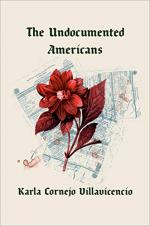|
This section contains 630 words (approx. 2 pages at 400 words per page) |

|
The Undocumented Americans Summary & Study Guide Description
The Undocumented Americans Summary & Study Guide includes comprehensive information and analysis to help you understand the book. This study guide contains the following sections:
This detailed literature summary also contains Topics for Discussion on The Undocumented Americans by Karla Cornejo Villavicencio.
The following version of this book was used to create the guide: Villavicencio, Karla Cornejo. The Undocumented Americans. One World: New York, 2020.
Karla Cornejo Villavicencio decides to write this non-fiction book on the eve of the 2016 Presidential election. She is determined to give voice to the thousands of undocumented immigrants who often struggle in a racist country that classifies them as manual laborers. Villavicencio is originally from Ecuador. Her parents move to the United States after borrowing money from a family member, and that family member keeps Villavicencio as collateral until the debt is repaid. She finally joins her parents, at the age of four, in New York City, a place where she now says she is from. Intellectually gifted, benefactors come forward to pay her education from Catholic school through Harvard University.
In Chapter 1 Villavicencio interviews immigrants on Staten Island to understand what it is like to be a day laborer. She explains that, historically, workers gathered on a corner waiting for day work. A potential employer will pull up, explain the job needing to be done and find someone willing and able to perform it. This does not guarantee that the immigrant worker will get paid for the day’s labor, and worker centers were created that provide advocacy for day laborers. These centers help to establish job price and see that the immigrant gets paid for labor completed.
Chapter 2 recounts how immigrants formed the majority of the cleanup crew after the World Trade Center tragedy on September 11, 2001. Villavicencio meets immigrants who spent weeks cleaning up the debris and dust from the fallen buildings. Physically, because of the toxic chemicals in the rubble and ash, many of the immigrants who did cleanup suffer from health conditions including cancer and asthma. They also suffer psychological anxiety and depression. Some immigrants receive compensation from the September 11th Victim Compensation Fund, but the funding is sporadic and inconsistent.
When Chapter 3 begins, Villavicencio opens up about her feelings regarding her abandonment in Ecuador. She travels to Miami to meet immigrants and understand how an underground healthcare system works. For example, dentists from other countries who do not possess a license to able to practice in the Unites States will do home visits. Some pharmacies will sell prescription drugs to immigrants without a prescription. She travels to botanicas, herbal and spiritual stores, to see the range of products available to immigrants who often resort to alternative medicines. Most immigrants cannot receive treatment in doctor’s offices or hospitals because they are uninsured—and immigrants are unable to purchase health insurance in the United States.
In Chapter 4 Villavicencio travels to Flint, Michigan to speak with immigrants regarding the lead-contaminated water. She notes the Latinx section of Flint is mostly boarded buildings. The residents recount the worry they had over water taste, color and feel, but officials kept insisting the water was drinkable. However, after finally divulging lead had contaminated the water, bottled water was provided by the state. Villavicencio speaks with immigrants who have cancer and other ill effects.
Chapter 5 brings Villavicencio to Willard, Ohio to meet with a family whose father was just deported by immigration. She details the emotional trauma the children, ages six to 15, and wife feel at his absence. Also, since the father was the income producer, his wife must now work long hours. Villavicencio also meets with two immigrants in sanctuary, the taking of refuge in a church, because immigration was about to deport them. Chapter 6 becomes more personal as Villavicencio recounts her father’s loss of job, placing additional stress on the family. She recounts additional immigrants from the New York area that speak of the loneliness of being an immigrant. She understands the great sacrifices her parents and many immigrants have made for their families.
Read more from the Study Guide
|
This section contains 630 words (approx. 2 pages at 400 words per page) |

|



